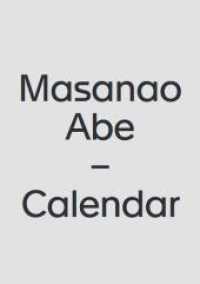- ホーム
- > 洋書
- > 英文書
- > Business / Economics
Full Description
Students are already strategists in their personal lives. This concise text, intended primarily for undergraduate seniors and MBA students, provides students with the know-how to apply effective strategies in their future careers. Strategic Management: Logic and Action provides a wide range of organizational examples along with worksheets at the end of each chapter. Students are encouraged to use the Web as a source of information, but to also interview people to assess actions within the context of organizations. The text is meant to be a useful guide for strategists facing new situations from the beginning of their organization careers. From the Preface: "Strategy is no longer the exclusive concern of generals. It is not something you wait to think about until you are the president of an organization. You need to understand strategic thinking right now, as a graduate entering the workforce, a newly appointed supervisor, or a mid-level manager.
Corporations, small businesses, non-profits, and public agencies - organizations of all kinds - are discovering how important it is for employees to understand why the organization interacts the way it does with customers, competitors, and other actors. Many then ask their employees to help strengthen current connections and invent new ones."
Contents
1. Define Strategy. What Are the Characteristics of Effective Strategy? How Are Strategies Influenced By Other Strategists? How Do They Lead Others? Why Are the Successes and Failures of Other Organizations Important? Conclusions for the Strategist. Key Concepts. Questions for Further Reflection. Notes. 2. Developing Resources. Which Firm Resources are Associated with Competitive Advantage? How Are Competitive Resources Created and Sustained? What Risks Are Associated with Resource Accumulation? How is Resource Accumulation and Deployment Strategically Managed? Conclusions for the Strategist. Key Concepts. Questions for Further Reflection. Notes. 3. Serving Customers. Why is the Customer Relationship Increasingly Critical? What is a Service Mentality? What Are the Guidelines for a Customer-Based Business Model? How Do Companies Gather Data to Identify and Understand Their Customers? Can the Customer Connection Be Overemphasized? Conclusions for the Strategist. Key Concepts. Questions for Further Reflection. Notes. 4. Seeking Opportunity. What Signals the Capacity to Develop Opportunity? What Are the Processes of Opportunity Development? What Are the Differences between Small Firm and Corporate Entrepreneurship? Is Ambidexterity the Answer? Conclusions for the Strategist. Key Concepts. Questions for Further Reflection. Notes. 5. Competing with Rivals. What Distinguishes Competitive Environments? What Affects Profit Potential in Different Environments? How Do Macro Forces Affect the Evolution of Competitive Conditions? How Do Asymmetries Help Explain Competitive Advantage? What Are Generic Strategies for Achieving Competitive Advantage? What Are the Characteristics of Hypercompetition? When Do Competitors Collaborate? Conclusions for the Strategist. Key Concepts. Questions for Further Reflection. Notes. 6. Specifying a Business Model. What Are Common Business Models? How Can Value Chain Analysis Contribute to Strategic Change? How Can the Life Cycle Be Used as a Source of Business Model Ideas? What Can Be Learned from Competitors, Customers, and Others? How Do Business Plans Differ from Business Models? Conclusions for the Strategist. Key Terms. Questions for Further Reflection. Notes. 7. Considering Corporate Strategy. How Do Strategies Pursue Growth? How Are Economic Transactions among Firms Facilitated? Can Diversification Leverage Core Competence? When Is Learning an Outcome of Alliance? Conclusions for the Strategist. Key Concepts. Questions for Further Reflection. Notes. 8. Thinking Globally. What Are the Advantages and Disadvantages of International Diversification? How Can Competitive Advantage Be Increased through International Expansion? What Are Alternative Strategies for International Expansion? What Are Alternative Entry Modes? What Are Significant Cross-Cultural Differences? Conclusions for the Strategist. Key Concepts. Questions for Further Reflection. Notes. 9. Acting Responsibly. What is Sustainable Strategy? How Are Standards for Corporate Governance Changing? What Are Internal Forces for Social Responsibility? What Intensifies Ethical Dilemmas? Conclusions for the Strategist. Key Concepts. Questions for Further Reflection. Notes. 10. Ensuring Execution. How Can Strategy Execution Support the Increasing Need for Flexibility? How Is Strategic Planning Changing? How Is Individual and Unit Performance Improved? Conclusions for the Strategist. Key Concepts. Questions for Further Reflection. Notes. 11. Managing Knowledge. Why Is Knowledge an Increasingly Important Source of Sustainable Advantage? What Are the Characteristics of Knowledge Needed by Companies? How Do Strategists Manage and Use Knowledge? How Do Organizational Systems Affect Knowledge Management? What Are the Most Important External Sources of Knowledge? Conclusions for the Strategist. Key Concepts. Questions for Further Reflection. Notes. 12. Providing Leadership. What Are Contemporary Definitions of Leadership? What Are the Most Important Activities of Strategic Leaders? How Are High-Performance Organizations Created and Maintained? Conclusions for the Strategist. Key Concepts. Questions for Further Reflection. Notes. 13. Personal Strategizing. What Are the Trends Shaping Future Work? How Is the Employment Relationship Changing? What Are the Most Important Career-Planning Activities? Why Be Purposeful About Work/Life Balance? Conclusions for the Strategist. Notes. Index.








